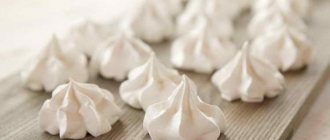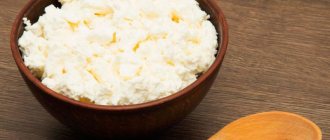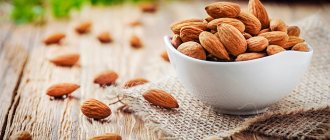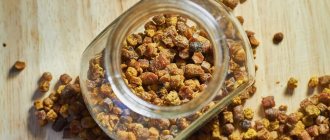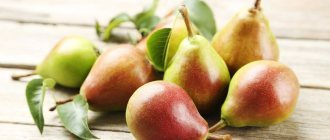Types of cottage cheese, their calorie content and nutritional value
Cottage cheese is classified into three categories: low-fat (up to 1.8 percent), semi-fat (9 percent), and full-fat (18 percent). There are intermediate subcategories, including the popular 5 percent. The calorie content of cottage cheese per 100 grams depends on the percentage of fat content. The higher it is, the greater the nutritional value of the curd mass.
Cottage cheese 5% calories
Compromise cottage cheese 5 percent has a calorie content of 121 kcal. It remains a dietary product, but has a more pleasant taste. Therefore, it is purchased for diets when they want to give up unnecessary additives. Homemade cottage cheese will have approximately the same calorie content if made with milk with 1.8 percent fat content.
The amount of protein per 100 g is reduced to 17.2 g. They are high quality and serve as an excellent basis for building muscle fibers. Proteins also help in the formation of other cells in the body.
Fat is always 5 percent. This is enough to give a pleasant taste while preserving nutrients. If the product is made at home, the percentage may vary slightly.
Cottage cheese 5% contains up to 1.8 g of carbohydrates, which is about a percent of the daily requirement. They are slowly absorbed and do not cause any harm to the figure if a person follows a strict diet. Despite the small percentage, the carbohydrates present, together with fat and protein, provide enough energy.
There are more useful substances in such a product than in a low-fat product. The composition of 5 percent cottage cheese includes the most important vitamins A and E, zinc, fluorine, copper, selenium, iron, and phosphorus. And the quality of calcium absorption increases significantly. Therefore, the product will be valuable for children during active growth of the body.
Calorie content of semi-fat cottage cheese 9%
Half-fat cottage cheese with 9 percent fat content is considered classic. Many nutritionists call it the best for proper nutrition or weight loss, as it combines moderate calorie content with a mild taste.
Nutritional value per 100 g is 159 kcal. The weight of proteins per 100 g reaches 16 g. They are slowly absorbed without loss, help strengthen muscle tissue and help during periods of increased stress. Fats are present in an average amount of 9 g. They are saturated with cephalin and lecithin, which are important for the construction of cell membranes.
Complex carbohydrates in semi-fat products increase to 2 g. Such a low figure still allows us to call a dairy product dietary and harmless for people losing weight, including those adhering to a ketogenic diet.
The presence of an increased number of vitamins makes the semi-fat curd mass more valuable for humans. Its composition is also characterized by an increased amount of calcium. To get the maximum benefit, it is recommended to avoid unnecessary additives, including sour cream, sweets, and fruits. They will increase the calorie content with the percentage of fat and affect the value of the dish.
Cottage cheese 18 percent fat
The calorie content of the 18% product is 232 kcal per 100 g. It is the most correct and complete type, which is confirmed by the recommendations of nutritionists. Despite the percentage of fat content, it cannot be called harmful in the diet when losing weight.
The volume of protein per 100 g is reduced to 15%. Its quality is no different from other types of fat, it is fully absorbed and used by the body to build new vital cells. The fat content increased to 18 g does not have a negative effect. The curd mass becomes pleasant to the taste, it can be comfortably eaten without unnecessary additives.
Cottage cheese with 18 percent fat content has 2.8 g of carbohydrates per 100 g. This is still not enough to provide the body with the daily requirement, but is still not harmful to the diet menu.
The increased amount of methionine is of particular value. This amino acid helps prevent unwanted fatty liver disease. It can also speed up recovery in children whose bodies are weakened after illness.
A contraindication for use can only be kidney pathology.
Calcined
The calorie content of a calcined product is practically no different from a semi-fat one. It provides the body with nutritional value of up to 160 kcal. The product differs in protein to a greater extent - 16.7 g. It is as complete and useful for strengthening physical fitness as in other types. Its growth is associated with a slight change in composition.
The fat content of cottage cheese is 9 percent, the same as semi-fat. Therefore, it can be eaten without additional ingredients without experiencing negative feelings. The taste remains unchanged and pleasant. The calcined product contains about 2 g of carbohydrates. In terms of quality and dietary compatibility, it does not differ from traditional ones.
The composition contains additional calcium added to the milk at the production stage. Therefore, this type of curd is especially useful for bone problems or injuries. However, it should be consumed sparingly, since even with a low calorie content, an excess of calcium will lead to metabolic disorders.
Cottage cheese from skim milk
Skim milk is the low-calorie skim milk left over from creaming. It is characterized by an increased amount of protein and value, which affects the nutritional value. The calorie content of skim milk curd is 136 kcal.
Per 100 g there is up to 20% protein. This increased percentage is achieved precisely from the return. This does not deteriorate the structural composition. The presence of fat remains at 2 percent. Therefore, the curd mass is a little dry, crumbly and dense. Eating it is sometimes difficult and not so tasty. Carbohydrates increase to 7 g, which is about 5 percent of the daily value. They still belong to the complex category and do not harm the diet.
Skim curd yields increased amounts of zinc, copper, potassium and calcium. Its general vitamin and mineral composition is similar to other types of fat and remains no less valuable. Substances missing from low-fat grains are present here in moderate amounts.
Compound
- Vitamins: A, B1, B2, C, PP. Also, fat-containing vitamins are present in very limited doses: A, E, D, since a low-fat product still contains a minimal amount of fat (up to 0.5%). However, the content of these vitamins is so minute that it is not perceived by the body in any way.
- Minerals: iron, potassium, calcium, magnesium, sodium, phosphorus, manganese, chlorine, copper.
Manufacturers, indicating “0% fat content” on the package, mislead the consumer, since it is impossible to prepare a completely low-fat product. In any case, it will contain a small amount of fat in the composition. Sometimes it reaches 0.5%.
The calorie content of low-fat cottage cheese is 105 kcal per 100 g. This allows us to classify this product as dietary. Regular, depending on the percentage of fat content, contains from 150 to 230 kcal / 100 g.
How is cottage cheese defatted?
The process of making a low-fat fermented milk product is no different from creating a regular one. The difference is that skim milk is used as the starting material.
The creation technology involves several stages:
- clarification, pasteurization and cooling of milk to the required consistency;
- adding a special starter (or rennet, which is used as an alternative method);
- milk fermentation process;
- cutting the formed clot;
- cooling the resulting mass.
This method is traditional, but to speed up the process of whey separation they resort to additional heating of the milk mass. This technology is also available at home. To do this, pre-prepared milk is left in a saucepan in a warm place for several hours (overnight is possible), until it sours. Then the semi-finished product is heated and the resulting whey is separated.
Nutritional value, calorie content of low-fat cottage cheese
The only source of energy for a person is food, which meets the needs of the body. The nutritional value of low-fat cottage cheese is characterized by its chemical composition, which determines the usefulness, color, aroma and taste of the fermented milk product. The table shows its calorie content and substances contained.
| Components (g) | Calorie content per 100 g | Distribution of BZHU | |
| Water | 70 | 110 kcal | Carbohydrates (g) - 3.4 |
| Unsaturated fats | 0,5 | Proteins (g) – 23 | |
| Saccharides | 0,4 | Fat (g) - 0.7 | |
| Organic acids | 1,2 | ||
| Cholesterol | 1,9 | ||
| Ash | 1,1 |
Low-fat cottage cheese is rich in the following vitamins: niacin (0.4 mg), riboflavan (0.25 g), thiamine (0.04 g). And the product also contains minerals - potassium (117 mg), iron (300 mcg), magnesium (24 mg), calcium (120 mg), phosphorus (189 mg), sodium (44 mg).
Unique properties
First of all, we need to clarify the term “low-fat.” According to production technology, it is impossible to completely remove fat from dairy products. Its maximum permissible value in a low-fat product reaches 1.8%. If in a store you come across milk, kefir or cottage cheese with a fat content below this indicator, then you can safely classify them as dietary, and the 0% label is more of a symbol indicating the type of product than an indication of the actual fat content.
As is known, the beneficial properties of cottage cheese in some cases are superior to those of other dairy products. It can be consumed even if you are lactose intolerant. This is due to the presence of lactic acid bacteria, beneficial microflora and the absence of sugar, which leaves the cottage cheese along with the whey.
Fermented milk products can support many processes in a healthy body:
- strengthen the immune system;
- eliminate the effects of stress;
- help the cardiovascular system and joints;
- improve the condition of skin, hair and nails;
- maintain good vision.
Calorie content and composition
The calorie content, which directly depends on the fat content, in such products is much lower, as already mentioned, up to 101 kcal. per 100 g.
The amount of carbohydrates is quite insignificant - 1.3 g per 100 g. If we talk about other useful elements, then there are many of them:
- protein - 18 g per 100 g;
- sulfur - 220 mg. per 100 g;
- calcium - 120 mg;
- phosphorus - 189 mg;
- potassium - 117 mg;
- chlorine - 115 mg;
- magnesium - 24 mg;
- sodium - 44 mg;
- as well as iron, selenium, copper, zinc and fluorine.
Cottage cheese is rich in vitamin C, it contains about 0.5 mg. per 100 g.
A complete set of B vitamins is one of the significant advantages of this product: thiamine (B1), riboflavin (B2), pantothenic (B5), nicotinic (B3) and folic (B9) acids are also contained in it, albeit in smaller quantities.
What is the specificity of 0% fat content?
Features of a low-fat product must be taken into account and used correctly:
- You need to understand that such an important substance as calcium is absorbed only in combination with animal fat. Accordingly, low-fat cottage cheese will not be able to enrich the body with calcium without special additives. The absorption of the substance is reduced by 40%.
- But protein, on the contrary, is contained and absorbed in even greater quantities - 18% versus 14.
- The situation with vitamins is approximately the same as with calcium. Low-fat foods contain significantly less fat-soluble vitamins such as A, D, E. Therefore, they must be obtained from other sources.
Cottage cheese is digested relatively quickly, 2-3 hours during the day. At night this process slows down to 5 hours.
Properties of low-fat cottage cheese
Despite criticism of low-fat milk, the benefits it brings to the body are no different from fatty products. It is valuable due to its high protein content - the main building material for tissues and muscles.
The second most important element in the composition is calcium. The component strengthens and ensures the healthy functioning of bones, teeth, hair nails, and the high phosphorus content normalizes the condition of the nervous system. Calcium is especially necessary for children during the period of active growth, as well as for pregnant and lactating women.
The presence and ratio of micro- and macroelements in the composition contributes to a colossal beneficial effect on the human body, which affects:
- Improving metabolic processes, helping to lose excess weight and improve well-being;
- Improving the functioning of the digestive system;
- Restoring the acid-base balance in the body;
- Increasing hemoglobin levels, which prevents the development of anemia, including in pregnant women. The process of hematopoiesis improves;
- Improving brain function, improving the quality of memory, concentration and attention. With regular consumption, the state of the central nervous system is normalized;
- Strengthening the condition of the heart and blood vessels, especially in old age;
- Kidney health;
- Improved vision;
- Normalization of skin and hair condition: cottage cheese lovers can be proud of healthy and smooth skin, elastic and shiny hair even at an advanced age.
A useful property for young children will be the prevention of the development of rickets, due to the saturation of bone tissue with calcium and its strengthening. The same action allows you to maintain the health of the musculoskeletal system in old age.
Nursing mothers need to include low-fat soft cottage cheese in their daily diet; it helps to enhance lactation and saturates breast milk with substances valuable for the baby.
Benefits and harms
The benefits of cottage cheese are obvious. Let me remind you again:
- Protein that contains all the amino acids we need and is easily digestible
- Contains calcium and phosphorus in an easily digestible form, which will ensure bone strength and prevent diseases of the musculoskeletal system
- Content of other macro- and microelements
- Has a diuretic effect. Therefore, it is used in diets to treat edema syndrome
Harm in most cases is associated with unfair production and individual intolerance.
Effect on calorie content of products added to cottage cheese
The calorie content of cottage cheese is influenced by the products that are added to it to improve the taste and enhance the beneficial properties. Most often it is eaten with dried fruits, nuts, honey, various types of preserves and jams, fresh berries and fruits, vegetables and herbs.
The table shows the calorie content of some products that can be added to cottage cheese.
Product (100 g) Calories (kcal)
| Nuts | |
| walnut | 698 |
| peanut | 571 |
| almond | 694 |
| hazelnut | 707 |
| cashew | 633 |
| Dried fruits | |
| dried apricots | 234 |
| raisin | 262 |
| prunes | 245 |
| dates | 305 |
| figs | 270 |
| Candied fruit | |
| a pineapple | 339 |
| banana | 346 |
| strawberry | 286 |
| orange | 300 |
| melon | 319 |
| Honey | |
| lime | 323 |
| buckwheat | 301 |
| acacia | 335 |
| sunflower | 320 |
| floral | 303 |
Cottage cheese can be used not only as an independent product, but also as a basis for many dishes. For those who are on a diet, it is important to know the caloric content of each of them.
- Dumplings with cottage cheese calorie content - 203 kcal when using low-fat cottage cheese as a filling (with a fat content of 19% - 284 kcal / 100 g).
- Cheesecakes made from low-fat cottage cheese (2%) contain 183 kcal.
- Cottage cheese casserole with a low percentage of fat - 168 kcal (with a fat content of 5 - 9% - from 213 to 249 kcal).
- Cottage cheese with sour cream (20% fat or more) is from 139 to 228 kcal.
An alternative to traditional options that are quite high in calories are dietary dishes. For example, cheesecakes can not be fried in oil, but baked in the oven.
An easy-to-prepare cottage cheese omelette is a high-protein, low-calorie dish. A low-calorie cottage cheese and carrot casserole will also diversify the menu.
Another healthy high-protein dish for dietary nutrition is called “belip” (“without lipids,” i.e., without fat): low-fat cottage cheese, cod fillet, raw chicken protein and onion are passed through a meat grinder and then baked in the form of meatballs.
What to cook
If you compare the taste of 0% cottage cheese with fatter options, then, unfortunately, it loses. This is quite natural; fatty foods always seem tasty to us.
However, in recipes, any cottage cheese is often replaced with low-fat cottage cheese without compromising the final result. In addition, it is supplemented with a large number of different products, the main thing is not to negate the dietary effect by consuming sweet or fatty additives.
Products that go well with cottage cheese and are not too high in calories:
- green apples;
- greens and garlic;
- bell pepper;
- carrot;
- zucchini;
- celery.
The classic combination is cottage cheese, honey and fruit. It is important to remember that the latter are a source of fructose; they have a different glycemic index. So cottage cheese with banana and honey is a wonderful, tasty dessert, but it’s unlikely to help you lose weight.
Low-fat cottage cheese pancakes
This dish is perfect for breakfast.
Ingredients for three servings:
- low-fat cottage cheese - 500 g;
- carrots - 100 g;
- celery root - 50 g;
- garlic - 1 clove;
- egg - 1 pc.;
- whole grain flour - 2 tbsp. l. + 2 tbsp. l. for deboning;
- soda - ½ tsp;
- salt - to taste.
Cooking technology:
- Mix cottage cheese, finely grated carrots, celery and garlic (add herbs to taste).
- Mix well, break the egg into it and stir again.
- Then put two tablespoons of flour and sprinkle soda on top. First mix the flour with soda, and then mix everything with the curd mass.
- Form into balls, flatten them slightly and roll in flour.
- Fry over low heat with a lid. This is how cheesecakes for those losing weight turn out fluffy.
You can fry without oil in a non-stick frying pan.
Calorie content 150 kcal. per 100 g.
Casserole with dark chocolate
Ingredients needed for three servings:
- low-fat cottage cheese - 500 g;
- low-fat kefir - ½ cup;
- egg - 1 pc.;
- semolina - 2 tbsp. l.;
- dried cranberries - 100 g;
- dark chocolate - 1/3 bar;
- vegetable oil;
- honey and warm water - 3 tbsp. l.
How to cook:
- Using a blender, mix cottage cheese, egg and kefir.
- Pour semolina into the resulting mass and mix well again.
- Finely chop the chocolate and add it along with the cranberries to the curd dough.
- Place the mixture in a baking dish and place in the oven.
- Bake for 40 minutes at 180 degrees.
- After this, the casserole needs to be removed from the oven and poured with honey, previously mixed with warm (not hot) water. Let it soak.
Calorie content 168 kcal. per 100 g. If you replace cranberries with raisins, they will increase slightly.
Benefits and contraindications of low-fat cottage cheese
A classic dietary option is cottage cheese made from low-fat milk. This product is low in calories while maintaining protein value.
This component is often prescribed as an auxiliary dietary supplement in the treatment of a number of diseases:
- diabetes mellitus;
- heart disorders;
- obesity;
- hypertension;
- pathologies of the gastrointestinal tract (ulcers, colitis, enteritis);
- atherosclerosis;
- damage to the gallbladder and liver.
The healing effect is due to the beneficial properties of the product:
- low-fat cottage cheese improves intestinal motility;
- restores lipid balance and general metabolism;
- stimulates brain activity;
- strengthens bones, improves the condition of hair and nails;
- normalizes the functioning of the central nervous system;
- serves as a prevention of oncology;
- increases hemoglobin levels in the blood;
- has a beneficial effect on the thyroid gland.
Cottage cheese is a source of phosphorus and calcium. The protein contained in the product is perfectly balanced in amino acid composition. Finally, the real benefit of low-calorie cottage cheese for the body is the presence of fermented milk bacteria in it, which ensure “order” in the intestinal flora.
Contraindications for use are associated with reduced digestibility. A minimal amount of milk fat leads to the fact that the product contains little cephalin, phospholipids and lecithin, which are involved in the transmission of nerve impulses. This “minus” can lead to metabolic disorders.
Another disadvantage of low fat (vitamin D) is the body's reduced ability to absorb calcium. Low-fat cottage cheese is considered a “poor” source of fat-soluble vitamins. The above disadvantages cannot be considered significant and can cause harm to the body if a person eats rationally and variedly.
Benefit
Cottage cheese (calorie content per 100 grams of fermented product, satisfies the body's daily need for most nutrients) is known for its unique properties and benefits.
In addition to the fact that adding cottage cheese to various dishes improves their taste, the lactic acid product has a number of benefits for human health:
- Improves digestion, has the ability to maintain an optimal balance of stomach acidity levels. Adding cottage cheese to your diet helps digest other foods, making it easier for the whole body to absorb food.
- Promotes weight loss; the calcium contained in cottage cheese limits the production of cortisol, which can provoke an increase in body fat.
- Cottage cheese is an excellent source of phosphorus and calcium, which helps strengthen the structure of teeth and bones. This is the most reliable source of meeting the body's calcium needs. Regular consumption of cottage cheese protects against diseases such as osteoporosis, arthritis, and reduces the likelihood of bone fractures and tooth decay.
- Due to the presence of live probiotic cultures in the product, it improves digestion processes and accelerates metabolism in the body, thereby helping to improve immunity.
- Systematic consumption of cottage cheese improves mental activity, concentration, and also increases the tone and physical activity of the body.
- The protein contained in cottage cheese is quickly absorbed and promotes the regeneration of muscle fibers, so cottage cheese is recommended for all athletes. Unlike protein meat and legumes, eating cottage cheese does not cause gas or heartburn.
- The amino acids contained in the fermented milk product, in combination with the group of B vitamins, have a beneficial effect on the central nervous system. B vitamins normalize metabolism. Vitamin B12 improves brain efficiency and helps the body absorb iron. Riboflavin converts carbohydrates into energy.
- Dairy products, especially cottage cheese, are rich in protein, calcium and vitamin D, so their regular consumption is beneficial for women's health, in particular for stabilizing hormone levels.
- Cottage cheese has restorative and healing properties; it is indicated for ulcers and gastritis, and for diseases of the endocrine system.
- Cottage cheese with a low calorie content of up to 5% per 100 grams should be consumed by children from six months and pregnant women to compensate for the lack of calcium in the body.
- Cottage cheese is good for older people, as it has the special property of strengthening joints and preventing dementia.
- Lightly salted cottage cheese helps lower blood pressure. The high content of methionine in the product helps reduce cholesterol levels in the blood. Due to this, blood circulation in the vessels improves and the risks of developing cardiovascular diseases are minimized.
- Magnesium in cottage cheese maintains normal blood sugar levels. This is a useful product for people suffering from type II diabetes, as it helps the body fight the disease and minimize its negative impact.
- The invaluable composition of cottage cheese is simply necessary for the female body. The minerals it contains, vitamin E and zinc, have a beneficial effect on the skin, nails and hair. Along with including cottage cheese in the menu, the animal product is often used as a homemade skin care product. Cottage cheese face masks make the skin soft, velvety and radiant.
- It is well suited for diets, since, despite the calorie content, the product quickly saturates the body and retains this feeling for a long time.
It is important to remember that only high quality and naturalness of the product is the main necessity for obtaining effective nutritional results. Interesting: Goat cheese contains much more calcium than its cow's milk counterpart.
How to choose ingredients for low-fat cottage cheese
Low-fat cottage cheese (calorie content should be checked on the manufacturer's packaging) is indicated for people who want to lose extra pounds, play sports or simply take care of the beauty of their figure. The best option would be a home-cooked dish.
The factory product, obtained from skim pasteurized milk and cultured starter (lactic bacteria), undergoes heat treatment established by technological standards and is passed through a special apparatus, using which cream separation is achieved. This creates the basis for the future dietary cottage cheese.
To prepare such food at home, kefir or milk is used.
It should be taken into account that store-bought skim milk is most suitable as a base raw material. Farm or natural product purchased at the market contains a high percentage of fat. Food derived from such a base will not benefit people who are overweight or have certain health problems.
Industrially produced milk does not require infusion and pasteurization, therefore it is recognized as the best raw material for producing low-fat cottage cheese. As for its preparation from kefir, the only requirement for such an initial component is its fresh quality. Sugar syrup is sometimes added to separate the whey.
For people suffering from a lack of calcium in the body, a suitable method for preparing low-calorie cottage cheese from skim milk and liquid sodium chloride (rock salt), which can be bought at a pharmacy. For 1 liter of liquid raw materials you will need 1 ampoule.
Many thrifty housewives consider it possible to use sour milk as a base. However, it should be borne in mind that such an ingredient may contain bacteria dangerous to the human body. A curd product obtained from such raw materials can cause poisoning and digestive disorders. Don't risk your own health!
Secrets of making low-fat cottage cheese
It is necessary to have such a product in the refrigerator when there are small children or elderly people in the family. To obtain dietary cottage cheese, you need to heat 1 liter of low-fat (2.5%) milk (up to 50 °C). Add 1.5 tbsp. l. calcium chloride or 3 g (½ tsp) of this substance in powder form. When the liquid curdles (formation of curd grains), carefully mix the composition.
Season the completely cooled mass with salt (to taste), and strain off the whey. The tender dish is ready to eat.
A few secrets of home cooking:
- powdered milk is not suitable for such purposes under any circumstances - only natural or pasteurized;
- The acidity of the final product depends on the decanting process, when the whey is separated. It is better to start preparing food in the evening, since overnight all the liquid will end up in the bowl placed for it. To speed up this stage, you need to attach a weight to the gauze bag with the future cottage cheese;
- for heat treatment of raw materials, you should use exclusively enamel dishes or stainless steel pans without any damage;
- In order for the finished cottage cheese to last longer, it needs to be placed in a convenient container and compacted a little - to remove all air voids;
- Your favorite fruits and berries, a pinch of cinnamon, whipped cream or chocolate sauce will help enrich the taste of the fermented milk product. Cranberries and strawberries, currants and prunes, hazelnuts and coconut flakes are elements with which you can not only decorate curd dishes, but also supplement them with vitamins and other useful substances.
Low-fat cottage cheese (the calorie content of the food depends on the composition of the raw materials used) will turn out to be as tasty as possible if, after the end of the heat treatment, it is given time to settle well. At the same time, keep the dishes open or under a gauze cloth.
Does low-fat cottage cheese help you lose weight?
The benefit of low-fat cottage cheese for dietary purposes lies, first of all, in its low calorie content.
The dietary properties of light fermented milk product are actively used in fasting diets to reduce excess weight and normalize the functioning of the gastrointestinal tract.
With a mono-diet, it will be useful to increase food intake up to 6 times, with smaller portions.
Examples of fasting days using low-fat cottage cheese:
- Curd and kefir. Meals during the day are divided into 6 times, 100 g of low-fat cottage cheese and 150 ml of low-fat kefir;
- Fermented milk. The composition of the product consists of 60 g of low-fat sour cream, 600 g of low-fat cottage cheese, 100 ml of milk, divided into 4 doses. You can also use rosehip decoction as a drink - 3 tbsp.
How to use it correctly
How much can you eat
If there are no contraindications for eating low-fat cottage cheese, then there is no need to limit it in your diet and count every spoon you eat. This product does not affect cholesterol levels and does not harm the figure, which is why it would seem to be safe. However, unreasonable use can still be harmful to health. Such cottage cheese is a complete source of protein, an excess of which can be dangerous, especially for people who do not exercise or lead an active lifestyle. Protein puts a strain on the kidneys and liver, and too much of it harms these organs. Blood vessels also react negatively to such an overdose. Therefore, in order to avoid troubles and derive exclusively benefit from low-fat, the amount of product consumed daily should not exceed 0.5 kg.
You can eat it even at night
This is one of the few products that nutritionists allow to be consumed even at night. As a dietary product, it will not harm your figure or health. However, you need to remember that a full stomach does not allow the body to fully rest during sleep, so the portion should be small, no more than 150 g.
Low-fat cottage cheese is a complete source of protein and does not harm your figure. Ideal for use during sports
Fasting day
The main food product for such a diet is low-fat cottage cheese. It is recommended to eat it throughout the day, but not more than 500 g, avoiding other sources of protein. The following ingredients can and should be added to cottage cheese:
- bran;
- pureed apple;
- zucchini and other unsweetened vegetables;
- honey;
- greens and garlic.
During the curd fasting day, you need to eat food often and in small portions. As a result of such a diet, it is possible to lose 2-3 kg.
Does low-fat cottage cheese help you lose weight?
The benefit for weight loss is the extremely low calorie content for a protein product. Dietary characteristics are often used as part of diets and fasting days. Using low-fat cottage cheese on a diet not only helps you lose weight easily, but also has health benefits. There are many different cottage cheese diets and recipes for fasting days.
Is it possible to eat low-fat cottage cheese at night?
Nutritionists' recommendations agree that consuming the product will be beneficial in the afternoon.
Due to the fact that the product contains minimal fat, it is generally accepted that consuming it at night does not cause harm, and the benefits are manifested in maintaining a feeling of fullness.
However, eating at night overloads the gastrointestinal tract, which does not operate at its maximum functionality during sleep.
In addition, eating a high-protein meal before bed can disrupt sleep. In addition to being harmful, late-night snacking suppresses growth hormones.
Taking this into account, consuming low-fat fermented milk product at night may be justified in the following cases:
- neutralizing excess insulin;
- as a sports nutrition: an evening snack with a protein product will be useful as a supply of building material for muscle fibers. Low-fat curd protein is usefully used by bodybuilders and weightlifters due to its ability to promote muscle growth over a period of time.
Advice from nutritionists
Let's see what the experts say:
- If you are on a diet, it is better to exclude the combination of cottage cheese with honey or jam
- Combine intake of different types of product - from low-fat to classic. After all, the human body needs animal fats
- Do not mix low-fat cottage cheese with sour cream to improve the taste. It’s better to use more palatable cottage cheese with 3-5% fat content
- If you eat curd product at night, be sure to brush your teeth afterwards. Since some bacteria and lactic acid can cause tooth decay
How long does it take to digest low-fat cottage cheese?
It may seem surprising, but fermented milk products, which are considered healthy, take several hours to digest. It depends on the quality and fat content. Therefore, low-fat cottage cheese is considered light: the body spends up to 2 hours to digest it. To fully understand the dietary benefits of this indicator, cottage cheese with a fat content of more than 3% based on whole homemade milk will require up to 5 hours. Costs for other dairy products such as yogurt, whey, glazed curds range from 5 to 10 hours.
The harm of low-fat cottage cheese - hidden dangers
Talking about the dangers of cottage cheese is blasphemy, unless we are talking about a low-quality product. Surely, you have come across non-grain cottage cheese, which contains special lactobacilli. By the way, there shouldn’t be any, because cottage cheese is made from milk and does not need any additional ingredients. Externally similar bacteria can remain in the product for only 2 hours, and from the moment the bag or packaging is opened, they multiply. Excessive numbers of bacteria will cause stomach upset.
Why can't you eat low-fat cottage cheese?
Why you can’t, or who it’s better not to eat low-fat cottage cheese, is children. Athletes and bodybuilders can eat any fatty or low-fat dairy products, but children need a balanced diet. The best type is considered:
- In the morning protein + carbohydrates.
- During the day fats + protein.
- Carbohydrate in the evening.
If you choose curd products as protein and carbohydrate analogues, this is what normal nutrition will look like:
- In the morning, eat 100 g of cottage cheese 5%.
- During the day, you can mix 7% fat cottage cheese with fruit or honey. This is a loading dose to stop hunger attacks. It is useful and necessary for children.
- In the evening, eat 3% cottage cheese.
In this way, the child's muscles will constantly benefit, and it is not necessary to always look for fat-rich foods. The main thing is that the salt and fats are natural, then the children will receive a natural increase in supplementary feeding. But women are advised to eat full-fat cottage cheese at night, and in the morning eat medium-fat milk. During the day, eliminate it altogether and add proteins and light carbohydrates to your diet.
Standards for consumption and storage of cottage cheese
This dairy product is undoubtedly healthy and helps you lose weight, but it is still a natural protein-calcium concentrate, and therefore you should observe moderation when consuming it. Excess protein can negatively affect kidney function.
And a product with high fat content increases cholesterol levels, which leads to obesity and the development of atherosclerosis. Granular cottage cheese is more useful, although it also has some contraindications, such as individual intolerance.
According to nutritionists, the average protein intake is 0.86 - 0.95 g/kg body weight. That is, the average person weighing 55 kg can consume 47 g of protein per day. But since it is known that 10 - 15% of protein from food is not absorbed, the amount should be slightly increased (about 50 g).
A pack of cottage cheese contains approximately 32 g of protein. This means that 1.5 - 2 packs is the daily requirement of protein for such a person, without additional products. But during the day we usually eat other protein foods, so experts recommend eating no more than 200 g of cottage cheese per day.
Another important point is the shelf life of cottage cheese. This product is unstable, so even with slight violations of the temperature regime, its quality deteriorates significantly.
- The shelf life of homemade, full-fat and low-fat cottage cheese at temperatures from 2 to 6 °C is 36 hours.
- Store-bought (with stabilizers) can be stored for 7 days, heat-treated - 14 days.
- Curd products are stored for 36 hours at a temperature of 0 - 2°C.
Cottage cheese is an important food product, one of the main sources of protein in our diet, along with meat and fish. It stimulates the growth of new tissues, improves fat metabolism, strengthens the nervous system, has a beneficial effect on the immune system and has many other beneficial properties.
What is the secret of the popularity of low-fat foods?
If you are into popular weight loss diets, then you know for sure that most of them are based on strict restrictions. Here you need to exclude fast carbohydrates or carbohydrates in general and consume only low-calorie foods.
The main source of calories and the enemy of everyone losing weight is, of course, fat. Hence the general fashion for everything low-fat. This trend has not bypassed dairy products. In fact, fat is not the enemy, but for some reason many people think so.
Perhaps the reason for its popularity also lies in the material component. After all, it is cheaper to produce a low-fat product than cottage cheese with medium and high fat content. And in the wake of the general fat-free mainstream, it is much easier to sell it at an inflated price.
But there is a positive aspect to the popularity of low-fat products. So, using the example of cottage cheese products, we can show that a fatty product can be harmful. The reason is the dishonesty of manufacturers, who find it cheaper to add palm oil or vegetable fats instead of milk fat.
Review of curd products
The abundance of brands in stores poses a difficult task for the buyer to make the right choice.
To make it easier, it is worth turning to various ratings conducted by research
At the top of many reviews is the “Savushkin” brand with low-fat cottage cheese “Savushkin Khutorok 1%”. It is recognized as natural, healthy and made according to all the rules without unnecessary additives.
This company also has soft cottage cheese “Tender 0%”. In its production, the rennet enzymes pepsin and chymosin are used, but there is no need to be afraid of this, they do not cause harm to the body.
They are from Prostokvashino
Products under the Prostokvashino brand, presented in almost any store, have three variants of low-fat cottage cheese in their line - 2%, 0.2% and soft cottage cheese 0.1%. All of them are natural in composition and do not include additives; they differ in taste and consistency. Soft cottage cheese is made using calcium chloride, so it contains slightly more than normal.
Reviews about the products of this brand are mostly positive, but there are also comments. Among items of similar fat content, reviews speak negatively about the taste of 2% cottage cheese, and in soft cottage cheese a reduced content of lactic acid organisms was found, 9 times less than it should be.
Who lives in the "House"
House in the Village cottage cheese products also have options. Low-fat cottage cheese is produced hard, with a fat content of 0.2%, and soft - 0.1%.
Reviews about the second option are more positive, although buyers note an unusual runny consistency.
The KBZHU of this product is also different; the hard one has significantly more protein - 18 g, and the soft one has 10 g.
Other brands
Cottage cheese "Vkusnoteevo", which also has its fans and regular customers, does not fit into the specified framework in terms of the amount of yeast. Based on the results of the studies, manufacturers were recommended to correct this deficiency.
Good reviews and adequate composition are present in the products “Green Village”, “Kubansky Milkman”, “Molkom”. But these options in convenient packages are not available in all regions. Due to its short shelf life, it is more profitable to sell cottage cheese closer to the place of production.
What do nutritionists advise?
Nutrition experts advise approaching this issue wisely. If you do not have a serious illness (atherosclerosis or kidney failure), then you should not fall into hysteria over the dilemma: what fat content of cottage cheese is better and healthier to eat? The fight against excess weight must be competent. It is better to eat classic cottage cheese, enjoy its wonderful creamy taste and enrich your body with unique natural nutrients. And you can easily burn calories by working out in the gym or jogging in a shady park. Be healthy and enjoy life!




